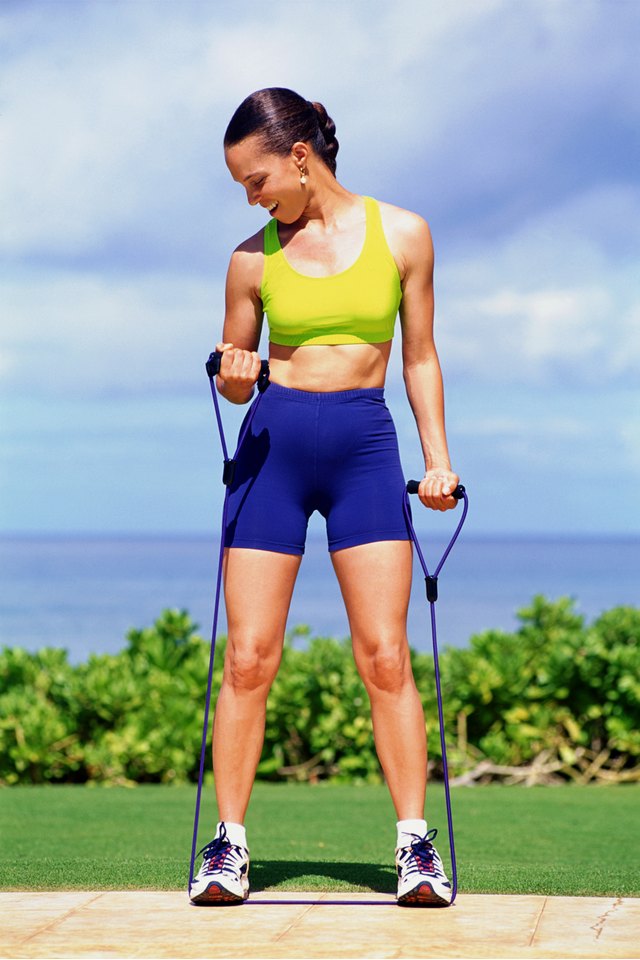How to Use Resistance Bands and How Many Calories Do You Burn?

Resistance bands enhance your selection of fitness equipment. Use them to rehabilitate an injury, increase strength or even for stretching. The bands pack up and travel well, so provide a useful option for vacation fitness or business travel. Resistance bands come in many forms, from a strip of elastic to tubing with handles. The amount of resistance varies from light to through moderate, then heavy. Choose your tension level based upon what feels comfortable, yet challenging. '},{'content':'If you weigh 160 pounds, you'll burn 365 calories in an hour-long strength training workout that includes resistance bands. If you weigh more, you'll burn more calories completing the same routine.
Biceps

Thinkstock/Comstock/Getty Images
Hold the handles of your band in either hand. Place the band on the ground and stand on it, securely anchoring the band under your feet. Stand with only one foot on the band to make this exercise easier.
Check your body alignment. Relax your knees, don't lock them. Pull your abs in toward your spine and relax your shoulders.
Bring your arms to a 90-degree angle, facing your fists to the ceiling. Press your elbows firmly into your sides.
Curl your fists up to your shoulders using a controlled motion. Slowly lower them back down to the starting position. Complete three sets of eight repetitions.
Keep your torso stationary during this exercise. Do not rock back and forth using your body and momentum to complete the curl.
Legs

Thinkstock/Comstock/Getty Images
Step both of your feet inside a circular band, keeping the band around both ankles. Stand at the far left side of the room with your feet about hip-width apart. Do not lock your knees.
Check your form. Pull your abdominal muscles in toward your spine. Keep your back straight and your hips squared. Place your hands on your hips.
Step out with your right foot a little more than shoulder width. Bring your left foot in to the right, keeping enough tension on the band so it doesn't slip. Continue side-stepping in this manner until you reach the right side of the room.
Repeat to the other side, traveling across to the left side of the room. Begin by traveling across the room and back just once. Work up to doing this three times in a workout.
Abs

Thinkstock/Comstock/Getty Images
Stretch your resistance band on the ground. Sit down, placing your bottom on one end of the band about 6 inches from the end. Lie down on the band so that it is flat underneath your spine.
Draw your abdominals in and rest your head on the band. Breathe normally -- don't hold your breath.
Lift both of your hands above your head and grab hold of the band. Initially, keep your arms bent with your elbows out to the side. To increase the difficulty, straighten your arms above your head and keep them straight for the entire series of crunches.
Curl your head and shoulders up off the ground, keeping a firm grasp on your band. Crunch the abdominal muscles for three small pulses before slowly lowering your upper body back onto the ground. Start with one set of eight of these crunches. Work your way up to three sets.
Tips
Check your band for weak spots before each workout.
Explore In Depth
References
- MayoClinic.com: Exercise for Weight Loss: Calories Burned in 1 Hour
- American Council on Exercise: Whole-Body Exercise Band Workout
- Sports Injury Clinic: Resistance Band Exercises
- Lopes JSS, Machado AF, Micheletti JK, de Almeida AC, Cavina AP, Pastre CM. Effects of training with elastic resistance versus conventional resistance on muscular strength: A systematic review and meta-analysis. SAGE Open Med. 2019;7:2050312119831116. Published 2019 Feb 19. doi:10.1177/2050312119831116
- Yeun YR. Effectiveness of resistance exercise using elastic bands on flexibility and balance among the elderly people living in the community: a systematic review and meta-analysis. J Phys Ther Sci. 2017;29(9):1695–1699. doi:10.1589/jpts.29.1695
- Shoepe TC, Ramirez DA, Rovetti RJ, Kohler DR, Almstedt HC. The Effects of 24 weeks of Resistance Training with Simultaneous Elastic and Free Weight Loading on Muscular Performance of Novice Lifters. J Hum Kinet. 2011;29:93–106. doi:10.2478/v10078-011-0043-8
- Perry B, Ciciurkaite G, Brady CF, Garcia J. Partner influence in diet and exercise behaviors: testing behavior modeling, social control, and normative body size. PLoS One. 2016;11(12):e0169193. Published 2016 Dec 29. doi:10.1371/journal.pone.0169193
- Kanamori S, Takamiya T, Inoue S, Kai Y, Kawachi I, Kondo K. Exercising alone versus with others and associations with subjective health status in older Japanese: The JAGES Cohort Study. Sci Rep. 2016;6:39151. Published 2016 Dec 15. doi:10.1038/srep39151
- Feltz DL, Ploutz-Snyder L, Winn B, et al. Simulated Partners and Collaborative Exercise (SPACE) to boost motivation for astronauts: study protocol. BMC Psychol. 2016;4(1):54. Published 2016 Nov 14. doi:10.1186/s40359-016-0165-9
Writer Bio
Based in Wisconsin farm country, Jami Kastner has been writing professionally since 2009 and has had many articles published online. Kastner uses her experience as a former teacher, coach and fitness instructor as a starting point for her writing. She has a Bachelor of Arts degree in secondary education from Trinity International University.
